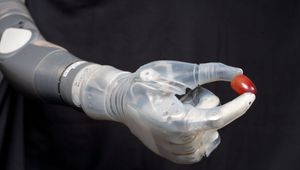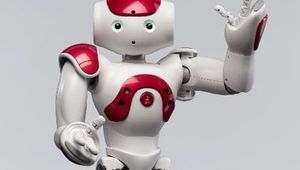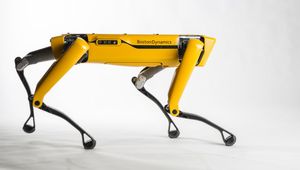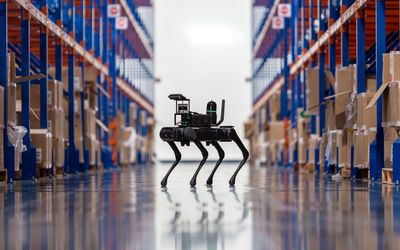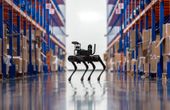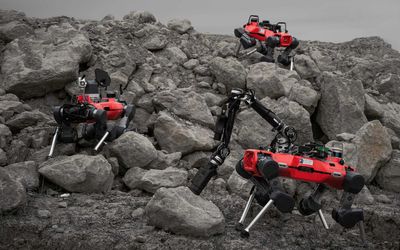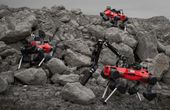ANYmal
ANYmal is a four-legged robot, designed to autonomously perform long endurance inspection.
Technical Specifications
| Weight | 30 |
| Height | 0.5 |
| Actuation | 3 |
| Joint rotation | 360 |
| Link length | 250 |
| Torque control bandwidth | +70 |
| Battery life | 2-4 |
| Power of onboard batteries | 650 |
| Full-speed running power consumption | < 280 |
| Environmental perception | |
| IP code | |
| Compliance |
Overview
Physically ANYmal resembles a medium-sized dog. It weighs 30 kg, is 0.5m tall, operates for 2-4 hours on a charge, and connects to a docking station independently. Anymal’s payload can range from simple sensors to complex robotic arms and the versatile machine was built specifically to work in the difficult surroundings of industrial sites, comprising of stairs, gaps, pipes and other obstacles.
The versatile machine can adapt its posture and omni-directionally move with statically and dynamically stable gaits.
To cope with impulsive forces at fast locomotion ANYmal contains custom developed compliant joint modules with integrated electronics. The robot is constructed of a single carbon-fibre lightweight body, with 12 identical joint units connected by simple mechanical links.
Environmental perception is enabled through rotating line-LIDAR sensors, stereo and wide-angle cameras; sensors in the rubber feet provide haptic information, enabling safe locomotion even in case the robot is completely blind. For industrial inspection, ANYmal is equipped with a pan-tilt head with various sensors, including an optical zoom and thermal camera, a gas detection sensor, an ultrasound microphone for gas leak detection, as well as artificial LED lighting.
ANYmal can survive falls from over 0.5m height; sensors are equipped with a fall-protection housing, foam absorbs the impact of side falls and a Kevlar belly protects from sharp objects below. It is sealed against water and dust ingress.
Design Goals
- Large mobility
- Fast and dynamic locomotion skills
- High robustness
- Simple maintenance
- Safe handling by a single operator
A quadruped design was chosen to meet the required mobility and versatility for operating in unstructured industrial environments.
Design Setup
Modular Design
The design goal of a rugged and simple maintain system, as well as simple setup was approached with a modular design for the hardware and software. Specifically, the modular joint units called ‘ANYdrive’ allow to create robots of different kinematic structure. In case of failure, these modules can be easily and quickly exchanged without special knowledge. The of ANYmal simplifies setup and maintenance.
Hierarchical Design
ANYmal is designed in a hierarchical manner: On joint level, every actuator module is connected over a CAN bus and works independently. This allows component-level ingress and ATEX protection as well as fast and simple maintenance in case of hardware failure.
On system level, computation is split among three independent computers that are connected through an internal network. The first computer (locomotion) hosts all real-time critical elements required for locomotion control and to interface the joint modules. The second computer (navigation) is responsible for environmental perception, localization, navigation, and mission execution, i.e. all software parts that are required to autonomously operate the robot. The third computer (inspection) runs all algorithms for inspection and detection.
Physical Structure

Image Design 02 - Overview
Physically, Anymal is constructed of a single lightweight body, and the 4 legs contain 3 identical actuated joints per leg, linked by simple, rigid mechanical links and connected with a CAN bus for power and communication. The legs have point feet.
References
Describes the design of the ANYmal project at a high level.
Provides a system overview of ANYmal and how it's optimized for operation in harsh environments. Goes into details regarding mechanical design, software architecture, drive system, and locomotion control.
Provides an insight into the approach taken by team LIO during the ARGOS Challenge, a robotics competition which stands for Autonomous Robots for Gas and Oil Sites.
Describes the underlying mechanics and actuation concept, illustrates the electronics and software setup, sketches out the applied locomotion control algorithms with appropriate references to their implementation, and finally summarizes the paper with a series of experiments highlighting the overall











